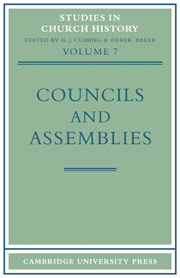Book contents
- Frontmatter
- Preface
- Contents
- Contributors
- Abbreviations
- Public welfare and social legislation in the early medieval councils (Presidential Address)
- National synods, kingship as office, and royal anointing: an early medieval syndrome
- The case of Berengar of Tours
- Ecclesiastica and Regalia: Papal investiture policy from the Council of Guastalla to the First Lateran Council, 1106–23
- Viri religiosi and the York election dispute
- Councils and synods in thirteenth-century Castile and Aragon
- The Byzantine reaction to the Second Council of Lyons, 1274
- The Council of London of 1342
- Education in English ecclesiastical legislation of the later Middle Ages
- The representation of the universitas fidelium in the councils of the conciliar period
- Nicholas Ryssheton and the Council of Pisa, 1409
- The condemnation of John Wyclif at the Council of Constance
- Some aspects of English representation at the Council of Basle
- The Council of Basle and the Second Vatican Council
- The Colloquies between Catholics and Protestants, 1539–41
- King James I's call for an ecumenical council
- John Hales and the Synod of Dort
- Assembly and Association in Dissent, 1689–1831
- The Convocation of 1710: an Anglican attempt at counter-revolution
- Laymen in synod: an aspect of the beginnings of synodical government in South Africa
- The First Vatican Council
- Kikuyu and Edinburgh: the interaction of attitudes to two conferences
The representation of the universitas fidelium in the councils of the conciliar period
Published online by Cambridge University Press: 12 March 2010
- Frontmatter
- Preface
- Contents
- Contributors
- Abbreviations
- Public welfare and social legislation in the early medieval councils (Presidential Address)
- National synods, kingship as office, and royal anointing: an early medieval syndrome
- The case of Berengar of Tours
- Ecclesiastica and Regalia: Papal investiture policy from the Council of Guastalla to the First Lateran Council, 1106–23
- Viri religiosi and the York election dispute
- Councils and synods in thirteenth-century Castile and Aragon
- The Byzantine reaction to the Second Council of Lyons, 1274
- The Council of London of 1342
- Education in English ecclesiastical legislation of the later Middle Ages
- The representation of the universitas fidelium in the councils of the conciliar period
- Nicholas Ryssheton and the Council of Pisa, 1409
- The condemnation of John Wyclif at the Council of Constance
- Some aspects of English representation at the Council of Basle
- The Council of Basle and the Second Vatican Council
- The Colloquies between Catholics and Protestants, 1539–41
- King James I's call for an ecumenical council
- John Hales and the Synod of Dort
- Assembly and Association in Dissent, 1689–1831
- The Convocation of 1710: an Anglican attempt at counter-revolution
- Laymen in synod: an aspect of the beginnings of synodical government in South Africa
- The First Vatican Council
- Kikuyu and Edinburgh: the interaction of attitudes to two conferences
Summary
The Council of Pisa was the fruit of a long period of gestation. Intermittently over centuries canonists had discussed where in various contingencies the supreme authority in the Church lay—with the pope, the cardinals, the universitas fidelium in a general council. Twice in the fourteenth century theory was nearly tested by practice, when Philip the Fair opposed Boniface VIII and when Louis of Bavaria faced John XXII. The final challenge was given by the Great Schism. Begun in 1378 it dragged on for decades, causing irreparable damage to Christian Europe. Neither of the rival ‘popes’ showed any genuine goodwill to end it. So others, particularly in France, lent a hand. When Benedict XIII in Avignon refused the via cessionis (abdication) and paid only lip-service to the via discussionis, the court of Paris withdrew its obedience and the theologians of the French universities justified the royal action. Canonists like Conrad of Gelnhausen and Henry of Langenstein wrote treatises to uphold the superiority of the universitas fidelium, i.e. a general council, over pope and cardinals. But who could summon a council? And who could best represent the universitas fidelium?
It had been the cardinals who had started the schism when, confident that they were the chief power in the Church, they declared Urban VT's election invalid. They were the prime movers in the summoning of the Council of Pisa and in its running. In Constance, four years later, those same cardinals were fighting to retain a semblance of their previous importance, and bishops in the four or five ‘Nations’ were the chief authority representing the universitas fidelium.
- Type
- Chapter
- Information
- Councils and Assemblies , pp. 177 - 196Publisher: Cambridge University PressPrint publication year: 1970



